Convector or oil cooler: equipment requirements and features
Very often, buyers have a question about what is better - an oil cooler or an electric convector, and even sellers cannot always give a qualified and complete consultation, which is why we decided to devote this review to comparing the two options and identifying their main advantages and disadvantages so that you can understand in question and on the basis of facts, decide in favor of a particular type of product.
One should not trust the opinion of those who are convinced of the advantages of one of the options, without giving good reasons, most likely the person used only one of the options, and he knows about the second only by hearsay.
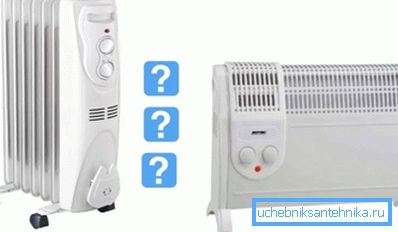
Basic hardware requirements
First of all, we will tell you what requirements any heater, regardless of its type, should meet, if the chosen option does not meet at least one of the points, it is better to refuse to acquire it:
| Fire safety | The design must include emergency shutdown nodes in case of unforeseen circumstances. This is very important when the equipment is left unattended and can cause a fire, a level sensor is usually installed in the oil radiators, which turns off the system when overturning, and the convectors are made so that the probability of fire is almost completely excluded |
| Efficiency | If we are talking about any device that works on electrical energy, the issue of its consumption is very relevant, because the price of energy is constantly growing, and the cost of heating, accordingly, rises in price. In this regard, the difference between the convector and the oil radiator is significant - the first option is more economical by 25% with the same characteristics |
| Efficiency | Here it is necessary to touch upon such a question as the rate of heating of the room and the stability of maintaining a certain temperature. Here again, the convector looks more preferable, since it heats the room quickly and has a small inertia, as a result of which the indicators you set will be respected. |
| Comfort | This may include the fact that if the installation has open spirals or heating elements, then it will inevitably burn dust particles, which is not very good. The options we are considering do not have such a disadvantage, which is a big plus. |
Tip! When choosing, we strongly recommend to purchase only products that have certificates of quality and are manufactured by well-known brands. It is best to read reviews on specialized resources on the Internet, there is a lot of information there and users share it, which guarantees its honesty.
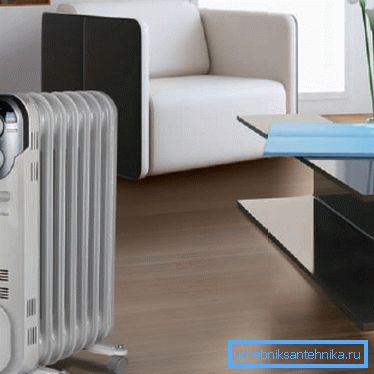
Pros and cons of each of the options
Now we will take a closer look at each of the solutions and talk about their main features. This will help you understand all the important nuances and make the right decision.
Oil radiators
To understand what is better - an oil cooler or a convector, it is necessary to understand the principle of operation of each of them, we will start with the first solution, since it has been used for a long time and quite widely.
There are several reasons for this popularity:
- Ease of use - you only need to put the element in the room and connect it to the electrical network, no additional preparatory measures are required.
- Very simple construction, which provides reliability and durability - the system is a tank filled with mineral oil, in which the heating element is placed. For safety, an electrical overheating protection system must be present in the system, and for ease of adjustment, a rheostat.
- Many variations vary in power., what allows to pick up an optimum product under practically any premises.

- Also it should be noted such a positive factor as low cost., After all, it was he who largely predetermined the popularity of oil structures among buyers.
- For ease of movement, a handle is usually made in the upper part, and the swivel wheels are located at the bottom..
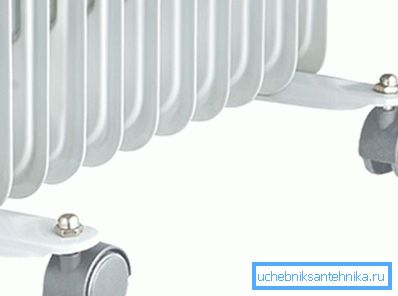
- Calculation of power at the height of rooms up to three meters is simple - 100 watts per one square meter.
To compare the convector and the oil cooler more fully, one can not but touch upon the shortcomings, and they are:
- In the process, the surface can heat up very much, which creates a danger of getting burned, this is especially important for those who have children, because they can not only burn themselves - the system can tip over and cause injuries to the child.
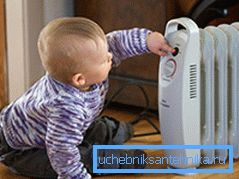
- The equipment has a large enough power consumption, so it will always be very costly to use it for heating, financial bills will be significant.
- The service life of such products is also small, over time, microcracks form and the oil begins to slowly evaporate, such faults are not eliminated in the workshops.
Convectors
The main difference between the convector and the oil radiator is the principle of operation, which is based on the physical process of convection, when warm air rises and cold goes down, the design is a housing with a heating element through which air passes and, heating up, exits through the grill from above.

To decide which is better - electric convector or oil cooler, you need to talk about the advantages of this option:
- The ability to purchase different configurations - products can be both mobile on wheels, and wall, and their shape may resemble the classic radiators, and may be a narrow and wide body, which is very convenient when installed on balconies.
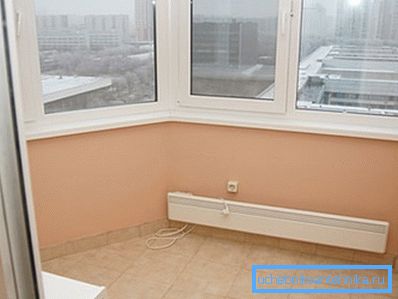
- Installing your own hands will not cause difficulties, it is enough to attach the system to the wall or put it on the floor and connect it to the power supply network.
- The heating process is very fast., as the process of air exchange when heated allows you to quickly raise the temperature throughout the room.
- Fire safety system meets the highest European standards, so that these elements can be installed in almost any room.
- The design management system allows you to adjust not only the temperature, but also the mode of operation by the time of day and by day of the week. This can significantly reduce energy consumption.

- Considering the difference between the convector and the oil radiator, it is impossible not to touch upon such a factor as the low temperature of the body heating., on average, it is 40-50 degrees, which makes this option safe, because the surface does not burn.
Note! When positioning the equipment in the room, try to position it so that small children cannot reach the controls.
As for the shortcomings, the following nuances can be noted:
- If the room was completely cold, it would take some time to heat up.
- The convection process contributes to raising dust, although it is also inherent in oil coolers.
- If the room has high ceilings, then the range of the convector may simply not be enough.
In general, the second one can say with confidence that the convector is an excellent solution for small rooms, and for living rooms it is good as an additional source of heat.
Conclusion
We hope that this manual will help you understand the features of each option, in general, we can conclude that the convectors are more rational and economical, but the price of oil radiators is noticeably less. The video in this article will talk about some of the important nuances in more detail and help you understand their essence even better.